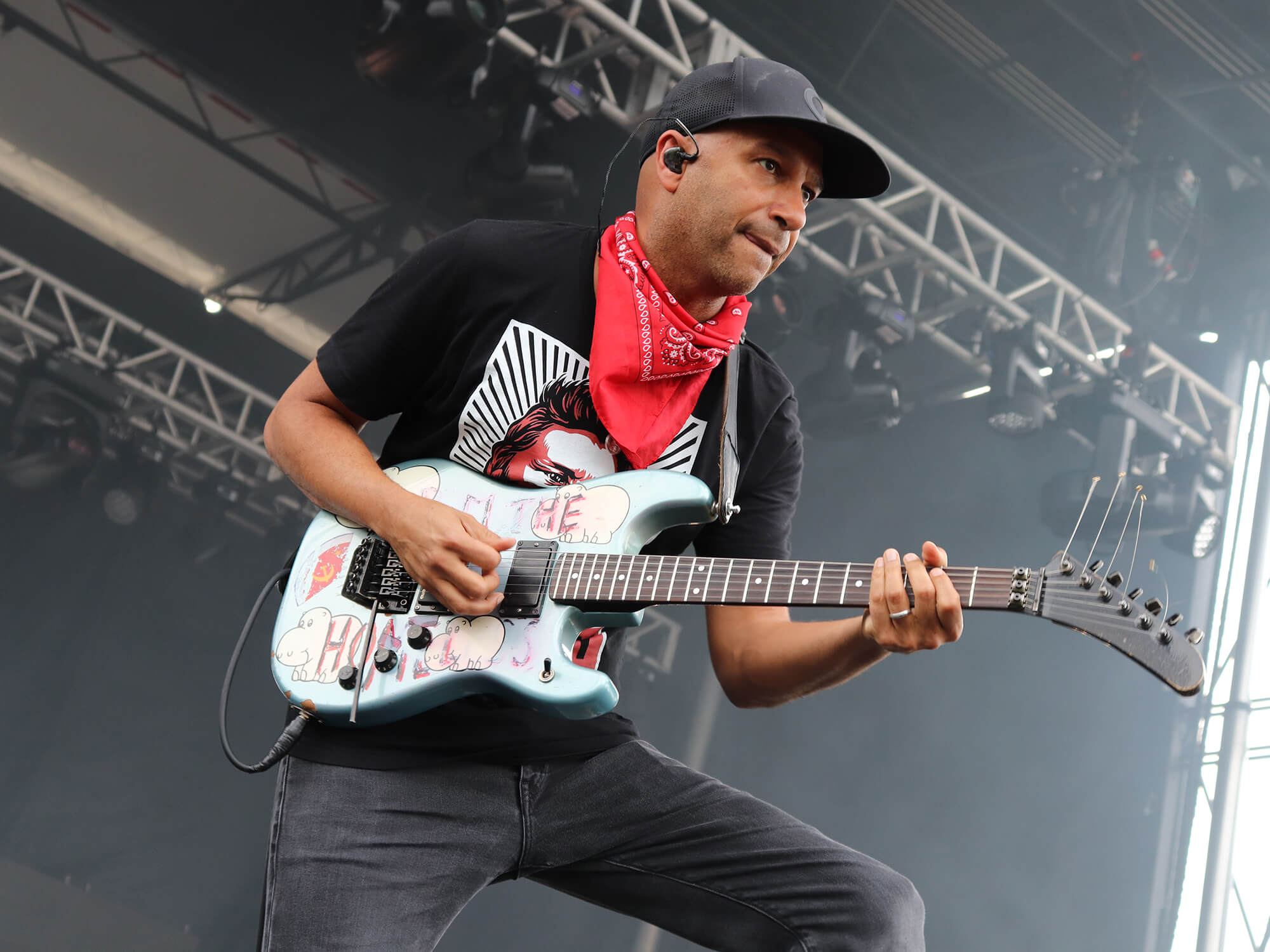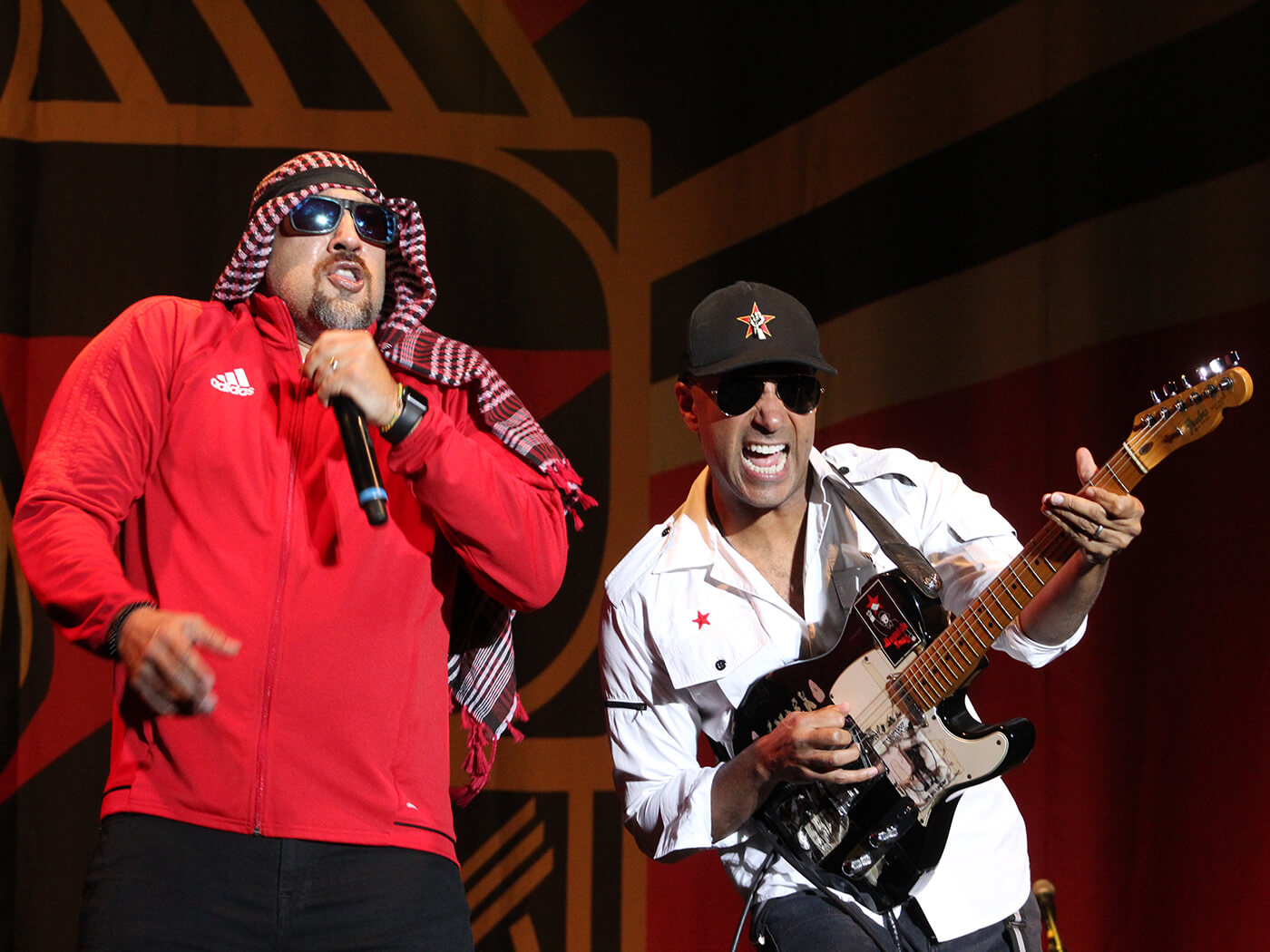The Gear Used on Rage Against The Machine’s debut album
We take a look at the gear used to shake the world In November of 1992, when Rage Against The Machine unleashed their debut album

Tom Morello on stage with his Arm The Homeless guitar. Image: Justin Beckner
In November of 1992, Rage Against The Machine unleashed their debut album onto the scene and it made an immediate impact. The album’s inflammatory lyrics were matched against a tapestry of riffs that would usher in a new era of heavy music. The orchestrator of these inventive riffs was Tom Morello, and the gear he relied on to forge his own sonic path through rock and roll history is a story unto itself. In this article we take a look at the gear used to shake the world in 1992.
- READ MORE: The Genius of… Real Life by Magazine
Before we get into the gear used, we must touch on the techniques used to record the album because they had just as much to do with the sound of the album as the gear itself. Garth Richardson, who produced the album told Nimbus School of Recording & Media in 2019 about his unique approach to recording the band on their debut album, “I could not bring them into a studio and put Tom in the corner with some headphones on, and Tim with some headphones on, and Zack with headphones on, and make it nice and clean. I wanted to capture that feel, that same thing. So I took a major risk here, I was this young kid and I went ‘I’m gonna put a PA system inside the room, put all the amps in the back rooms, and I’m gonna have it as a show.’ There was no click, there was no ProTools, there was no offsetting. There was only real, live.”
All of the basic tracks were done live, with minimal overdubs. Only two guitars were used for the initial live tracking and a third guitar was used for the aforementioned overdubs that were added later on. The two guitars Morello relied on for the live tracks were his “Arm The Homeless” Guitar and his Telecaster.

The “Arm The Homeless” guitar began its life as a custom build that Morello commissioned when he first arrived out in Los Angeles. It was built by a shop called Performance Guitar USA in 1986 – the owner of the shop, Kenny Sugai [who had previously built guitars for Frank Zappa and Steve Vai] recalled that the original specs of the guitar were based on a Fender Stratocaster. It came with Seymour Duncan JB pickups, a Floyd Rose tremolo, a Fender C-type neck shape. The pickup selector switch on the lower horn was on the original, and Kenny claims to have used an aircraft switch for extra durability. As one might imagine, Tom goes through selector switches pretty often. The original neck featured a beefier truss rod as well. I assume Tom let him know he was not going to be gentle with it.
Morello didn’t like the custom build and spent the next several years changing almost everything about it before deciding to stop searching for the perfect instrument and instead focus on making do with what he had. The alder body is the only original part from the shop currently on the guitar. The graphite neck currently featured on the guitar came from a throw away bin behind Nadine’s Music in Santa Monica, CA. It features a “Fathead” which is essentially just a piece of brass screwed to the back of the headstock – it was an old mod based on the thought that increasing the mass of the headstock increases sustain. Some people used it to balance out guitars with light necks. Tom claims that his didn’t add any sustain but he kept it on there anyway. The pickups are EMGs – the neck is actually a single coil in disguise as a humbucker. I believe they are EMG H or HA models.
A lot of people refer to a “kill switch” on the guitar but this is just a standard 3-way pickup selector. He turns the bridge pickup volume to zero and the neck to whatever volume he is using and the switch alternates between the silent bridge and the loud neck pickups. Keep that in mind if you’re ever wanting a kill switch effect without any modifications. The “Arm The Homeless” Guitar has remained Morello’s go-to for any songs constructed in standard tunings.
The other main guitar used by Morello on this record [and all subsequent recordings] for any songs that required a Drop D tuning is a 1982 American Telecaster. He needed this for Drop D tunings because the Arm The Homeless guitar had a Floyd Rose and a locking nut, making it difficult to drop the tuning of one string. These days you can use a mod called the D-Tuna for Floyd Rose systems but it’s possible that Morello wasn’t aware of this at the time. In any case, he traded his roommate a 50-watt Marshall amplifier for the guitar.
The guitar used for the overdubs is vastly less famous than the other two. In 2020, Morello posted a photo of this guitar to Instagram. The guitar is now known as the “Taco Bell” Les Paul and remains in Morello’s possession. It appears to be stock. According to Morello, the guitar was used for overdubs on “Killing In The Name Of” drawing into question the longstanding claim that the tone on that riff came purely from single coil pickups.
As far as pedals and amps, Morello has stated in an interview with Ultimate-Guitar.com in 2006 that he has used the same setup for every RATM record: “It’s identical. It’s unchanged, for every RATM album, every Audioslave song, every show. It’s a Marshall 2205 head, a Peavey 4×12 cabinet which is embarrassing to admit but it’s true and it sounds alright. Which of course I had to ratchet the Peavey off [the logo] the second that I bought it to keep my shame to a minimum. The pedals are an MXR Phase-90 [prior to Audioslave, Tom used an Ibanez DFL Flanger]; a DOD EQ pedal set for a boost for solos, a DOD digital delay pedal; the original Digitech Whammy pedal, not the re-make original Digitech but the original Whammy pedal. And there’s a [early 80s model] CryBaby wah and sometimes a DOD tremolo pedal.”
